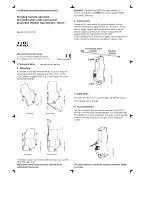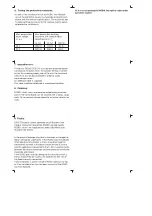
7. Insulation test:
The device DS 261 / DS 271 must be disconnected before
carrying out insulation tests. If insulation testing is carried
out on the incoming supply side of the unit, the functional
earth must also be disconnected in order to avoid
measurement errors.
An additional label is supplied.
This label should be displayed in a prominent position.
8. Cleaning:
RCBO´s which may have become soiled during assembly
work in the switchboard can be cleaned with a damp, soapy
cloth. On no account should corrosive or similar solvents be
used.
9. Faults:
STOTZ Residual current operated circuit Breakers with
integral Overcurrent protection (RCBO) are high quality
RCBO´s which are subjected to careful adjustment and
testing in the factory.
In the event of damage (e.g. due to transport or storage) no
repairs should be undertaken. If the RCBO trips immediately
when being commissioned, a check should be made for
connections to earth in the down-stream electrical circuits
and the appliances connected to them. Any insulation faults
between the neutral conductor and the protective conductor
should be eliminated.
If the RCBO does not trip during the first functional test, a
check should then be made as to whether the test circuit
has been correctly connected.
If the installation is correct and the RCBO continues to trip
or if the functional test has not been successful the RCBO
must be replaced.
10. In case of opening the RCBO, the right to claim under
guarantee expires.
6. Testing the protective measures:
As well as the functional test of the RCBO, the effective-
ness of the protective measures should be tested for com-
pliance with the relevant specifications. The maximum per-
missible earthing resistance for the residual current-opera-
ted protective switching is:
Max. permissible
Max. permissible earthing
touch voltage
resistance with rated residual
U
L
a.c.
operating current I
∆
n
10 mA
30 mA
300 mA
25 V
2500
액
833
액
84
액
50 V
5000
액
1666
액
164
액







